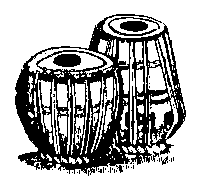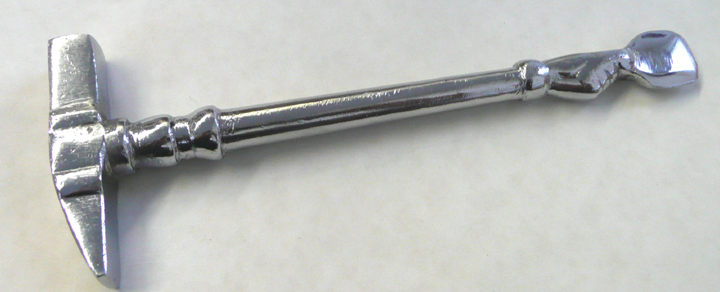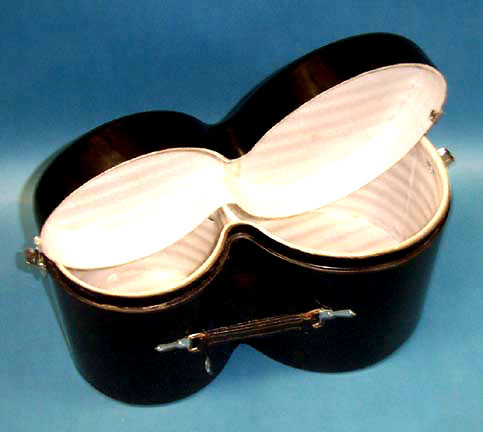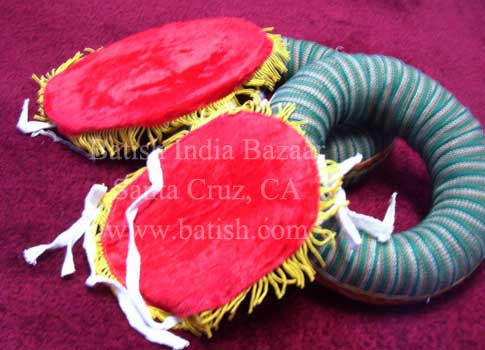Pandit Shiv Dayal Batish
Raga Manavati
Ashwin Batish and family Live
The UC Theater, Berkeley, California.
Meena Batish
Words by Ghalib
Music by S.D. Batish
Phone: (831) 423-1699

Tabla Lesson #2
Buying a good Tabla Set
by Ashwin Batishand Pandit Shiv Dayal Batish

So you are ready to spend your money on the best Tabla set this side of the Ganges ;-) .... Well, here are some tips to help you in your decision.
The Dagga Choices
Material Choices: Clay, brass/copper (standard weight), brass/copper heavy weight.Clay drums, although still around in certain parts of India, are more a novelty nowadays for the obvious reason that they are hard to care for. Therefore I will not delve further into this. If you own one and have a specific question, email me and I'll try and help.
If you find a shopkeeper trying to sell you an expensive tabla set chances are that the Dagga of this set will be the extra heavy type. Many of my students have bought into this, some over my objections, but then they find out why I'm against buying these.
What I'm trying to say here is that an expensive set may seem to justify a heavier instrument if weight is what you were buying. The mis-conception here is that .....
Heavier is better for the sound.... on the contrary... heavier translates into lower volume! The heavier chassis kills the resonance gained from the drum walls. The skilled maker of this drum will melt lead on the bottom of a thin wall tabla. This gives you the weight and keeps the resonance intact! But these are increasingly hard to find. Indeed you might have to special order one.
Heavier is sturdier.....or "heavy dagga drums are more stable to play." This is true but technique is more important. The dagga tends to rock more as your hand moves over it. Especially if you try to make sliding bass sounds on the drum. With practice you can do this without problems and to reduce friction (often the cause of the rocking) use talcum powder.
Tabla Choices
Today the tabla can be purchased in many varieties of woods. Some of these are not even worth mentioning. Just remember if it looks bad it probably is. A good tabla will have a clean looking skin. Its straps will look smooth and even. Its dowels will look uniform. The general feel of the drum will hint of quality!The most common types of materials used for a tabla are clay, sheesham wood, tun wood, and mango wood.
I see clay tablas every now and then and they sound pretty good too but I cannot see myself trying to tune one lest my hammer finds an unintended mark :-)
The sheesham wood tablas are probably the best. The wood is heavy and the sound of the tabla is crisp and vibrant. I have played tablas made out of tun and mango wood. They don't sound that bad. Whatever you do, stay away from drums that have oval looking heads; this is a sign of warping or just bad design. These are also very hard to tune properly. Also make sure there are no surface cracks on the wood as this could be a "growing" crack. I've seen tablas where the crack looked superficial but after six months the crack became substantial. This is usually caused by the drying factor of the wood. If you do somehow end up with a crack on the side of the wood, fill it immediately with a good quality wood filler and varnish the drum. Don't delay this because contact of raw wood with air opens the crack up further. Another thing that you can check is the weight. A lighter weight tabla will not sound very good and will not be too stable while playing.
Tabla Pudi
Finally, a good tabla pudi is the heart and soul of that inimitable tabla sound. Healthy, ringing, and resonant tones are only possible with a very good quality pudi. Pudis are made from goat skin and deer skin. They are both good although the deer skin ones look very white and are soft to the touch. They are also very delicate and tear easily. So you need to care for them. Goat skin pudis are tougher but the skin may have superficial blemishes and/or dis-coloration. This should not affect the tone.Good tabla pudis are assembled with great skill. The maker hails from a generation of Tabla walas (family business). I have seen a whole family clan from the youngest children to the oldest members doing the necessary procedures. The art of pudi making is indeed one of great endurance and skill.
First they have to find the right piece of skin. The thickness is very important. The under-belly of the goat is used as this is the softest and the most uniform in thickness. Then it is cured, cleaned off and de-haired. Flat pieces of the best quality skins are separated to be used as the main head material. Smaller pieces are isolated to be used as secondary "chanti" (edge) and backing material. Some of the thicker skin material is made into threading material for the "gajara" (braiding) around the pudi and the thickest and toughest material is cut into continuous strap material. This is used for the final assembly of the pudi to the tabla and dagga.
The actual making of the pudi is quite amazing to watch but it is beyond the scope of this article so I'll talk about this another time. But it is important to know that the process of applying syahi is the most crucial point to the creation of really good pudis. The syahi material is composed of hide glue, india ink, and iron filings rolled into a doughy ball and it is applied with a rolling action.
If you look at your tabla's syahi, you'll notice concentric circles. The smallest circle (about the size of a nickel) is the final one in the center of the syahi. Notice also that the syahi gets thicker as it comes towards the center. Know then that tablas that have more circles (between 5-6 plus) have had more syahi work done on them and will, in most instances, sound better than the ones with only a few such circles (2 - 3). I call these the rush job!
The syahi is put on the pudi in layers. This causes it to gradually build as each layer is rolled on. The process is as follows: The ball of syahi is held in the palm of the hand and as it rolls the syahi dries on the pudi. New material is deposited on the dried areas as the tabla wala patiently continues this process. when one area is finished, he starts on the next circle which is about an eighth of an inch inwards. This continues until he reaches the very center of the pudi.
Again, it is fascinating to watch and probably has no replacement. After the syahi dries, the syahi actually cracks into very little mosaic pieces. This is normal. Many of my students have a worried look when they receive their first tabla set. This mosaic cracks on the syahi is important as it helps in the resonance of the drum head. But sometimes a piece of the syahi comes loose and creates an obnoxious buzz in the tone. The reasons for this are varied. If the tabla set is new it could mean that the head is too old and the syahi has dried out. There is a way to fix this problem and I'll talk about this in another article.
Accessories
Tabla paraphanelia is crucial to proper tabla tuning, cleaning, and playing. Some of this should come with the Tabla set. Some you'll have to gather. Here it is....
1. Tabla Hammer

You need a good hammer! This is very important. The best ones are made out of brass or copper. One side is flat and square the other shaped like a blunt flat chisel. The blunt edge is at least 1/8th of an inch thick and about 1/2 nan inch wide. The other end of the hammer should taper to a flat wide finish as this end has special use. I'll talk about this later.
2. Talcum Powder - very important!

This serves multiple purposes. Powder is good for reducing friction. So when you really get going on the tabla, your heel will slide better on the dagga taking out smooth sounding glides. The powder also dries sweat; a mortal enemy of the syahi. Finally, it smells really good :) Some people are allergic to talcum. In this case, try and get cornstarch based powder. While playing the tabla, apply little amounts only. Too much of this can start to cake up on the tabla heads and then you will need to remove this very carefully.
3 Carrying bag or Case for your set

A proper case or gig bag is a must when you are dealing with a set that can change tuning at a moment's notice. It's funny how you will drop a bunch of money on a good quality set and oftentimes hesitate in buying a good case or padded bag to protect it. We all think of such extras as an unnecessary expense. But I high;ly recommend you get one when you get your tabla set. There are a number of options. Fiberglass case, padded nylon fabric case, duffle bags, hat cases, etc. whichever one you decide on, it is better than nothing. I would get one with pockets so you can put your hammer, powder, and other extras organized. Finally it is simply easier to carry the set in one container rather than lugging them separately.

A tabla case secures the deal and gives you the added peace of mind that your investment is protected. It is also handy to control the humidity for the temperature variations that can easily change and in some cases damage the instrument.
4. Tabla Covers - also very important!

A cover is always a good idea when you want to protect a valuable investment. For a tabla, this can really be a life saver. A well made cover can not only keep dust and dirt away from your tabla heads but they can protect against accidents, discourage others from playing on it improperly, and protect it from temperature extremes. The thing to remember is that the rings are well made and are the right size for your tabla. Many times, they are made a certain diameter and the tabla or the Dagga drum might be too big or too small relative to the size of the Dagga or the tabla. This will result in the drums either rocking excessively on the rings or simply bottoming out. If the Bass drum bottoms out and touches the floor some unwanted tones result.
I am glad you all are enjoying my articles here in RagaNet. I would really appreciate it if you would respect my writing by not copy and pasting this information on another site without seeking my permission.
Ashwin Batish
Batish Institute of Indian Music and Fine Arts
1310 Mission Street, Santa Cruz, CA 95060. U.S.A.
Voice: (831) 423-1699 / Fax: (831) 423-5172
Join Ashwin Batish's Fan Page on facebook!!
Issues:
1 • 2 • 3 • 4 • 5 • 6 • 7 • 8 • 9
|
|
|
email: info [at] batish.com
copyright ©1995 - Present Time ---- Batish Institute. All rights reserved. Intended For Personal Use Only. No part of the information here may be reproduced or utilized in any form or by any means, electronic or mechanical, including photocopying and recording, or by any information and storage retrieval system, without specific written permission from the Batish family.
